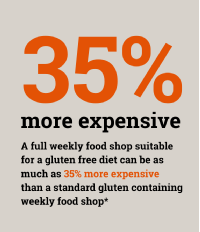Campaign to make gluten free food more affordable and accessible
We are on a mission to make gluten free food more affordable and accessible for people with coeliac disease. We’re calling on policy makers and the food industry to work with us to address the urgent challenges faced by the coeliac community and, in so doing, avoid a cost of living crisis becoming a future health crisis.
What's the problem?
Today, too many people with coeliac disease are struggling to access the food they need to stay well. The gluten free diet is the only treatment for coeliac disease, yet it costs significantly more and its harder to find on the shelves. The cost of living crisis threatens to make this even worse.
Our research found that:
- The cheapest gluten free loaf of bread is 6.1 times more expensive than the cheapest gluten containing loaf, gram for gram
- The weekly food shop suitable for a gluten free diet can be as much as 35% more expensive
- 7 in 10 people find shopping gluten free ‘adversely affects their quality of life’
- Almost 8 in 10 people struggled to afford gluten free products with those on the lowest incomes hit hardest by this additional cost
And whilst NHS support on prescriptions remains in place in Wales, Scotland and Northern Ireland, it has increasingly come under threat in England, with nearly half of the population living in areas cut adrift from support. That’s why we launched our cost of living campaign.
The campaign so far...
In March 2023 we launched our cost of living campaign with the publication of our report, 'The Gluten Free Diet: What does it cost and why does it matter?’ which highlighted the inequality of pricing for gluten free food for those that need it to maintain their health. The report provided a snapshot of the true cost of maintaining a gluten free diet and confirmed the shocking additional cost of gluten free staple products.
Building on that work, we asked our community to help us gather more information during their regular shopping trips. We had nearly 1,000 people take the time to share their experiences and published our second report in June 2024 with updated data, including the findings from this survey.
The campaign has been covered in national and regional press and the issue has been raised repeatedly in Parliament. Thousands have written to their local MPs and Integrated Care Boards (ICBs) and over 22,000+ people signed our petition to protect gluten free prescriptions for those with coeliac disease. In March 2025, we handed the petition into 10 Downing Street as part of day of action in Parliament that saw patients, healthcare professionals and politicians come together to urge action on this issue.
Thank you to everyone who has supported the campaign so far and for being part of this amazing effort!
You can read our 2023 and 2024 reports below:
- The Gluten Free Diet: What does it cost and why does it matter? - 2023
- The Gluten Free Diet: What does it cost and why does it matter? - 2024 update
What’s next
Our day of action in Parliament was an enormous milestone for the campaign and we’d like to thank everyone who joined us on the day and all those of you who have supported the campaign. But our visit to Number 10 is not the end of the journey! We are liaising with the Government and hope to be able to share positive developments with you soon as we seek to tackle this postcode lottery. In the meantime, we will also continue to work with contacts in industry, so that we can ensure everyone has access to the affordable gluten free staples products they need to stay well. Keep your eyes peeled for exciting new updates on the campaign—we’ll be sure to update you every step of the way!
How you can get involved
Our voice is only as strong as the community we represent and our initial success in raising awareness of the cost, access and availability of gluten free food has only been because of your incredible support. Thank you! If you haven't already, here's how you can get involved:
 1. Share your story
1. Share your story
We want to know how maintaining a gluten free diet is affecting you financially on a day-to-day basis, how you are coping with the rising cost of your food shop and if you are currently receiving prescription support to access gluten free food or have had prescription support withdrawn in your area. Share your story on social media and tag us or fill out the form below.
2. Shout about it
Use our letter templates to make change at a higher level:
- Contact your local ICB (non prescribing areas of England only)
- Contact your local Member of Parliament
Find out if you have access to gluten free staples on prescription in your area using our postcode tool here
Are you struggling financially?
If you’re struggling, we would recommend approaching your GP, as the ultimate decision on whether to prescribe gluten free products is down to your GP and some areas have exceptionality policies that can allow for support in individual cases where there is a clinical need. Beyond this, we also have some information on managing a gluten free diet on a budget which you can access below and may be of help. More generally, you may find Turn2us helpful. The charity helps people to gain access to financial support in times of hardship and may have information that’s of interest.
 Seven Day Meal Plan – your budget meal booklet
Seven Day Meal Plan – your budget meal booklet
Helpful hints on how to eat well gluten free on a budget.
